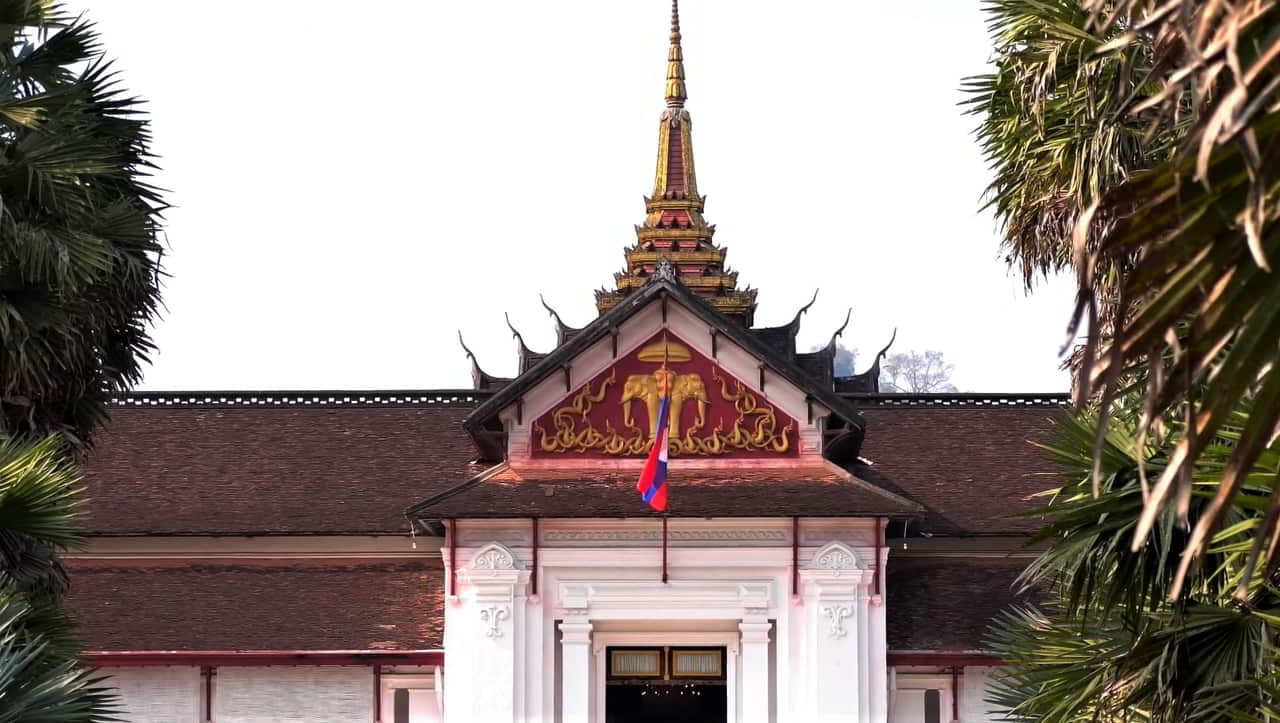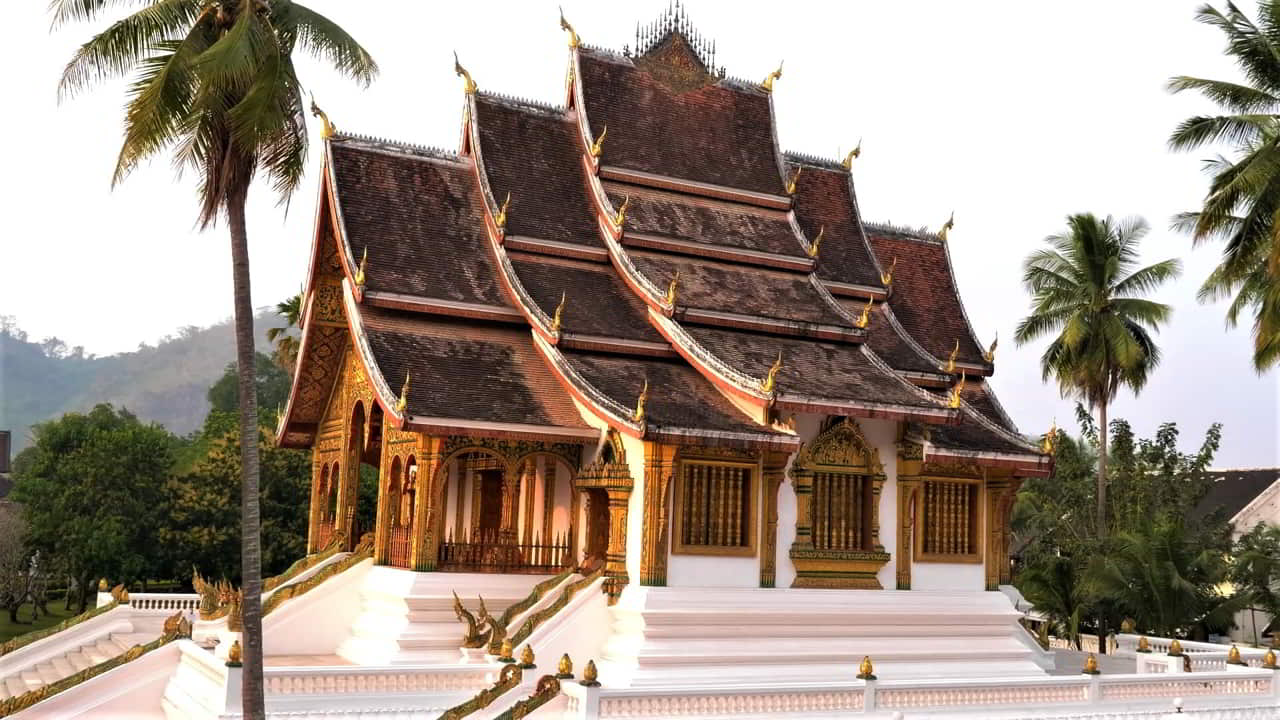
Luang Prabang Highlights: Uncovering Cultural and Natural Heritage
Luang Prabang boasts a host of must-see attractions that reflect its rich cultural and natural heritage. Here is a selection of sites not to be missed during your visit to this emblematic city of Laos.
Wat Xieng Thong: An architectural treasure
This iconic temple is one of the oldest and most beautiful in Luang Prabang. It is known for its elegant architecture, golden mosaics and detailed carvings.
“Wat Xieng Thong” (Lao: ວັດຊຽງທອງ), mean “Temple of the Golden City”. This Buddhist temple was built between 1559 and 1560 during the reign of King Setthathirath. The temple has played a crucial role in the history of Laos, whether for royal coronations or major religious celebrations.
Its distinctive structure, the Central Sim, features nine cascading roofs adorned in gold. The temple has been restored many times since its creation in the 16th century, including a substantial contribution from France as protectorate of Laos between 1893 and 1953.

Practical Information for Wat Xieng Thong
- Location: Wat Xieng Thong
- Opening Hours: Daily from 08:00 to 18:00
- Admission Charge: 20,000 Kip
- Dress Code: Appropriate attire is required.
Kuang Si Waterfall : Nature Éblouissante

Kuang Si Waterfall is multi-tiered with pools of turquoise water fed by the surrounding mountains. The main waterfall, 60 meters high, offers an impressive and very photogenic scene.
Practical Information for Kuang Si Waterfall
- Location: Kuang Si Waterfall is situated just under 30 km from Luang Prabang.
- Travel Time: Approximately one hour (at a leisurely pace).
- Entrance Fee: 25,000 kip per person – free for children.
- Opening Hours: 08:00 AM – 5:30 PM. Open Every Day.
- Paid Parking Available.
- Dining Options: Refreshments are available at the parking area, before the main entrance, and at a restaurant near the waterfall.
The Legend of the Kuang Si Waterfalls
An ancient legend tells of the creation of the Kuang Si waterfalls by a benevolent water spirit. In times past, the village endured a relentless drought, leaving its residents in desperate need. In their despair, the villagers prayed earnestly to the water spirits for assistance. In response to their pleas, a spirit emerged from the depths of the earth, crafting a majestic waterfall and turquoise pools that brought the long-awaited coolness. Consequently, the inhabitants survived, thanks to the benevolent gift of the water spirit. The waterfalls then became a symbol of blessing for the entire community.
Royal Palace (Haw Kham) of Luang Prabang
This magnificent building, once a royal residence, stands as an impressive example of traditional Lao architecture. Today, it serves as a museum showcasing a collection of royal artifacts.
The royal palace, known as Haw Kham, was constructed between 1904 and 1909 during the French protectorate for King Sisavang Vong. Following the abolition of the monarchy in 1975, the palace transitioned into a museum. The architectural style seamlessly merges French Beaux-Arts influences with traditional Laotian motifs. The surrounding gardens host various structures, including the Haw Pha Bang, designed to house the precious Buddha Phra Bang statue.
Within the museum, visitors can explore murals, royal artifacts, and the Phra Bang statue itself, crafted from gold, bronze, and silver. These treasures offer a glimpse into the rich history and cultural heritage of Laos.

Practical Information for Royal Palace (Haw Kham) of Luang Prabang
- Royal Palace - Haw Kham
- [Official Website] (https://www.luangprabang-laos.com/Musee-national)
- Open every day from 08:00 to 11:30 and from 13:30 to 16:00
- Admission fee: 30,000 Kip
- Proper attire required
Mount Phousi : The Panoramic View
Phousi Mountain is a sacred site towering 100 meters above the city. Built between 1904 and 1909 during the French protectorate, it houses a stupa erected by King Anourouth. Enjoy an unparalleled view of the city from the summit. The name “Phousi” means “luminous mountain” in Lao, symbolizing benevolence. The path has four entrances, each with cardinal stairs. At the summit, you’ll find That Chomsi, a 24-meter stupa adorned with seven levels representing Buddha’s reincarnations, offering a breathtaking panoramic view. Choose the morning for a peaceful ascent.

Practical Information for Phousi Mountain:
- Location :Mount Phousi
- Opening Hours: Open 24/7, every day.
- Admission Fee: 20,000 Kip.
- Note: Expect a large crowd during sunset.
Almsgiving to Monks in Luang Prabang

Attending the almsgiving ceremony, known as “Tak Bat,” in Luang Prabang is a deeply meaningful cultural experience. Each morning, monks emerge from temples to receive food offerings from the faithful, who are encouraged to give in accordance with Buddhist tradition. Luang Prabang, a UNESCO World Heritage site, provides a majestic backdrop for this spiritual ceremony. Participants are advised to rise early, dress modestly, and give with humility. Whether you are a curious observer or a practitioner, this authentic experience offers insight into local culture and Buddhist spirituality.

Practical Information for Monks’ Almsgiving
- Where? In the heart of the city.
- When? Every day at sunrise.
- Attire: Appropriate clothing is required, covering shoulders and knees.
- Behavior: Maintain humility, show respect, and observe silence during the ceremony.
Luang Prabang Night Market: Shopping and Local Flavors
Every day from 5:00 PM to 9:30 PM, the night market takes place in the heart of the city, facing the former royal palace. Inaugurated in December 2002 for Christmas celebrations, this market, initially called the “Candle Market,” has persisted and expanded over time. It now gathers hundreds of exhibitors offering a variety of items such as stone chess sets, silk scarves, embroideries, wooden crafts, religious articles, Buddhist paintings, and much more. Negotiations are common, although Laotian traders are not inclined to engage in bidding wars. The increasing influence of foreign products has been felt in recent years, influenced by globalization and tourism. The market concludes around 9:00 PM, but the latest finds are available until 10:00 PM.
Luang Prabang Night Market is the perfect place to buy artisanal souvenirs, clothing, jewelry, and traditional Laotian items.

Practical Information for Luang Prabang Night Market:
- Location: Luang Prabang Night Market - Chaofa Ngum Rd
- Operating Hours: Every day from 5:00 PM to 9:00 PM.
- Free Entry
Tat Sae Waterfalls: Intimate Nature
Less crowded than Kuang Si, these waterfalls are accessible by boat, offering a more secluded natural experience. The Tat Sae Waterfalls, located 20 km from Luang Prabang on the southern road to Vientiane, are captivating from July to February when the water flow is abundant. Less touristy than Kuang Si, they are often frequented by young Laotians in the summer for swimming. The cascades provide “stair-step” bathing spots for relaxation and a natural hydro-massage. Access is by boat after crossing the Nam Khan River, and elephants are sometimes present. It’s advisable to arrive early for tranquility or on Sundays for a family-friendly atmosphere.
From February to July, Tat Sae Waterfall may be dry or have very limited water flow. It is recommended to check before planning your visit.

Practical Information for Tat Sae Waterfalls
- Location : Tat Sae Waterfalls
- Open every day from 08:00 to 17:00.
- Admission fee: 20,000 Kip.
- Transportation options: Tuk-tuk (negotiable price), scooter, or bicycle (45 minutes).
Excursion on the Mekong River and Visit to Pak Ou Cave
Pak Ou Cave, also known as Tam Ting Cave, is located on the banks of the Mekong River, approximately 25 kilometers north of Luang Prabang. This picturesque destination is perfect for a delightful boat trip, offering breathtaking landscapes along the river and a serene ambiance.

Pak Ou Cave: Practical Information
- Location: Pak Ou Cave. The caves are located 25 km from Luang Prabang.
- Transportation: The boat journey from Luang Prabang takes approximately 2 hours one way and 1 hour for the return trip.
- Note: The boat ride is both comfortable and conducive to short naps interspersed with photo opportunities!
- Admission fee: 20,000 Kip for foreigners.
Wat Mai Suwannaphumaham: Spiritual Heritage
Wat Mai Suwannaphumaham, commonly known as Wat Mai, stands as an iconic Buddhist temple in Luang Prabang. Its distinctive architecture, featuring a four-tiered roof and frescoes depicting daily life and the legend of Vessantara, makes it a spiritual and cultural treasure in the heart of the city. Built in 1796 and restored in 1821 by King Manthathourath, it hosts religious ceremonies. “Wat Mai” translates to “new monastery,” reflecting its role in renewal. In Lao, “Suwannaphumaham” conveys the magnificence and grandeur of a golden temple.

Practical Information for Wat Mai in Luang Prabang
- ** Location:** Wat Mai Suwannaphumaham
- Open every day from 08:00 to 17:00.
- Admission fee: 10,000 Kip.
- Note: Ensure to cover your shoulders and knees and remove hats/caps as well as shoes before entering.
Traditional Arts and Ethnology Centre: Cultural Preservation
Established in 2006, the Traditional Arts and Ethnology Centre is dedicated to safeguarding the diverse cultures of Laos. Housed in a UNESCO-protected historic building, the center showcases garments, personal items, and religious artifacts to promote understanding of Laotian ethnic lifestyles and traditions. The museum also offers books, photographs, and local crafts. The permanent exhibition focuses on the Akha, Hmong, Tai Lue, and Khmu, illustrating their unique cultural features.

Practical Information for Traditional Arts and Ethnology Centre:
- Traditional Arts and Ethnology Centre
- Open from Tuesday to Sunday, 09:00 to 18:00.
- Admission fee: 25,000 Kip.
- Average visit duration: 1 hour.
In addition, information about Luang Prabang and Laos.
Find out more about Luang Prabang and Laos. Explore historical landmarks, hidden gems, diverse cities, and unique experiences in this Southeast Asian destination. Discover the beauty and cultural richness of Luang Prabang and Laos.














